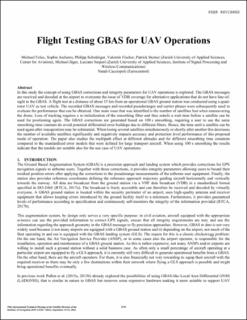Please use this identifier to cite or link to this item:
https://doi.org/10.21256/zhaw-26006Full metadata record
| DC Field | Value | Language |
|---|---|---|
| dc.contributor.author | Felux, Michael | - |
| dc.contributor.author | Jochems, Sophie | - |
| dc.contributor.author | Schnüriger, Philipp | - |
| dc.contributor.author | Fischer, Valentin | - |
| dc.contributor.author | Steiner, Patrick | - |
| dc.contributor.author | Jäger, Michael | - |
| dc.contributor.author | Sarperi, Luciano | - |
| dc.contributor.author | Cacciopoli, Natali | - |
| dc.date.accessioned | 2022-11-11T10:17:07Z | - |
| dc.date.available | 2022-11-11T10:17:07Z | - |
| dc.date.issued | 2022-09 | - |
| dc.identifier.isbn | 978-0-936406-32-9 | de_CH |
| dc.identifier.issn | 2331-5954 | de_CH |
| dc.identifier.uri | https://digitalcollection.zhaw.ch/handle/11475/26006 | - |
| dc.description.abstract | In this study the concept of using GBAS corrections and integrity parameters for UAV operations is explored. The GBAS messages are received and decoded at the airport to overcome the issue of VDB coverage for alternative applications that do not have line-of-sight to the GBAS. A flight test at a distance of about 15 km from an operational GBAS ground station was conducted using a quad-rotor UAV as test vehicle. The recorded GBAS messages and recorded pseudoranges and carrier phases were subsequently used to evaluate the performance that can be obtained. One main issue that was identified is the number of satellites lost when maneuvering the drone. Loss of tracking requires a re-initialization of the smoothing filter and thus entails a wait time before a satellite can be used for positioning again. The GBAS corrections are generated based on 100 s smoothing, requiring a user to use the same smoothing time constant do avoid potential differential error buildups due to different filters. Hence, the time until a satellite can be used again after reacquisition may be substantial. When losing several satellites simultaneously or shortly after another this decreases the number of available satellites significantly and negatively impacts accuracy and protection level performance of this proposed mode of operation. The paper also studies the multipath effect at different altitudes and for different smoothing time constants compared to the standardized error models that were defined for large transport aircraft. When using 100 s smoothing the results indicate that the models are suitable also for the use case of UAV operations. | de_CH |
| dc.language.iso | en | de_CH |
| dc.publisher | Institute of Navigation | de_CH |
| dc.rights | Licence according to publishing contract | de_CH |
| dc.subject | GBAS | de_CH |
| dc.subject | UAV | de_CH |
| dc.subject | Navigation | de_CH |
| dc.subject.ddc | 629: Luftfahrt- und Fahrzeugtechnik | de_CH |
| dc.title | Flight testing GBAS for UAV operations | de_CH |
| dc.type | Konferenz: Paper | de_CH |
| dcterms.type | Text | de_CH |
| zhaw.departement | School of Engineering | de_CH |
| zhaw.organisationalunit | Zentrum für Aviatik (ZAV) | de_CH |
| dc.identifier.doi | 10.33012/2022.18428 | de_CH |
| dc.identifier.doi | 10.21256/zhaw-26006 | - |
| zhaw.conference.details | 35th International Technical Meeting of the Satellite Division of The Institute of Navigation (ION GNSS+ 2022), Denver, USA, 19-23 September 2022 | de_CH |
| zhaw.funding.eu | No | de_CH |
| zhaw.originated.zhaw | Yes | de_CH |
| zhaw.pages.end | 1588 | de_CH |
| zhaw.pages.start | 1576 | de_CH |
| zhaw.publication.status | publishedVersion | de_CH |
| zhaw.embargo.end | 2023-03-30 | de_CH |
| zhaw.publication.review | Peer review (Publikation) | de_CH |
| zhaw.title.proceedings | Proceedings of the 35th International Technical Meeting of the Satellite Division of The Institute of Navigation (ION GNSS+ 2022) | de_CH |
| zhaw.author.additional | No | de_CH |
| zhaw.display.portrait | Yes | de_CH |
| Appears in collections: | Publikationen School of Engineering | |
Files in This Item:
| File | Description | Size | Format | |
|---|---|---|---|---|
| 2022_Felux-etal_Flight-testing-GBAS-for-UAV-operations.pdf | 1.15 MB | Adobe PDF |  View/Open |
Show simple item record
Felux, M., Jochems, S., Schnüriger, P., Fischer, V., Steiner, P., Jäger, M., Sarperi, L., & Cacciopoli, N. (2022). Flight testing GBAS for UAV operations [Conference paper]. Proceedings of the 35th International Technical Meeting of the Satellite Division of the Institute of Navigation (ION GNSS+ 2022), 1576–1588. https://doi.org/10.33012/2022.18428
Felux, M. et al. (2022) ‘Flight testing GBAS for UAV operations’, in Proceedings of the 35th International Technical Meeting of the Satellite Division of The Institute of Navigation (ION GNSS+ 2022). Institute of Navigation, pp. 1576–1588. Available at: https://doi.org/10.33012/2022.18428.
M. Felux et al., “Flight testing GBAS for UAV operations,” in Proceedings of the 35th International Technical Meeting of the Satellite Division of The Institute of Navigation (ION GNSS+ 2022), Sep. 2022, pp. 1576–1588. doi: 10.33012/2022.18428.
FELUX, Michael, Sophie JOCHEMS, Philipp SCHNÜRIGER, Valentin FISCHER, Patrick STEINER, Michael JÄGER, Luciano SARPERI und Natali CACCIOPOLI, 2022. Flight testing GBAS for UAV operations. In: Proceedings of the 35th International Technical Meeting of the Satellite Division of The Institute of Navigation (ION GNSS+ 2022). Conference paper. Institute of Navigation. September 2022. S. 1576–1588. ISBN 978-0-936406-32-9
Felux, Michael, Sophie Jochems, Philipp Schnüriger, Valentin Fischer, Patrick Steiner, Michael Jäger, Luciano Sarperi, and Natali Cacciopoli. 2022. “Flight Testing GBAS for UAV Operations.” Conference paper. In Proceedings of the 35th International Technical Meeting of the Satellite Division of the Institute of Navigation (ION GNSS+ 2022), 1576–88. Institute of Navigation. https://doi.org/10.33012/2022.18428.
Felux, Michael, et al. “Flight Testing GBAS for UAV Operations.” Proceedings of the 35th International Technical Meeting of the Satellite Division of the Institute of Navigation (ION GNSS+ 2022), Institute of Navigation, 2022, pp. 1576–88, https://doi.org/10.33012/2022.18428.
Items in DSpace are protected by copyright, with all rights reserved, unless otherwise indicated.